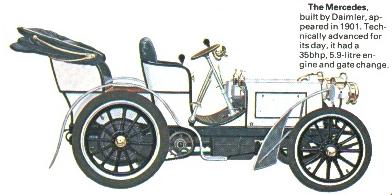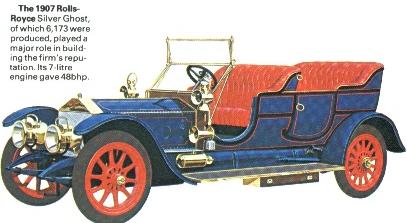History of Cars ~ Part 1
![]()
Motor car, road vehicle which first appeared in the 19th Century. The first cars were propelled by the steam, but such vehicles were not a success and the age of the motor car really dates from the introduction of the petrol-driven horseless carriages of Gottfrield Daimler and Karl Benz (1885-86). The internal combustion engine for these cars had been developed earlier by several engineers, most notably by the German, Nickolaus Otto, in 1876. The main components of a motor car, from then till now, are a body or chassis to which are attached all other parts - including the engine or power plant, the transmission system for transferring the drive to the wheels, and the steering, braking and suspension mechanisms for guiding, stopping and supporting the car. A few experts assembled the first cars, but Henry Ford and R. E. Olds in the USA began modern mass-production in the early 1900s. By this means, the cost of a car was drastically reduced, and more people could afford done. In most modern car factories component parts are put together on assembly lines - slow-moving conveyor belts. Each worker usually has a specific task, example fitting doors or crankshafts. Bodies and engines are constructed on separate assembly lines which converge when the engine is installed. Overhead rail conveyors move heavy components to and along the assembly lines, and lower them into position. At a later stage on the assembly line such items as lamps are fitted, and electrical, braking and control systems are tested. The fully assembled car is road tested before sale.
![]()
The automobile was not invented overnight. It took shape from an accumulation of technical advances that resulted in a light and efficient engine. The accepted "fathers of the modern motor car" are two Germans, Karl Benz (1844-1929) and Gottfried Daimler (1834-1900), who built their first petrol-fuelled motor vehicles within a few months of each other (1885-6).
More than a hundred years earlier, the first self-propelled road vehicle had rumbled through the streets of Paris at nearly 5km/h (3mph) when Nicolas Cugnot (1725-1804) demonstrated his steam-driven wagon.
The German Nikolas Otto (1832-91) made the first four-stroke internal-combustion engine in 1876 and in 1885 Daimler had installed a small four-stroke engine in a cycle frame. He drove his first four-wheeled petrol-driven vehicle round Cannstatt in 1886. In neighboring Mannheim, Benz had tested his three-wheeled car.
Daimler licensed the French firm of Panhard and Levassor to build his engine. Levassor placed it at the front of his crude car and it drove the rear road-wheels through a clutch and a gearbox. Thus in 1891 the first car to use modern engineering layout was seen. Within three years of the appearance of the first Panhard France was staging motor races on public road.
At the turn of the century, petrol, steam and electric
power shared almost equal popularity for powering cars. Steam was well
tried and reliable and electric vehicles held the land speed record.
France had several established motor manufacturers - Panhard, Peugeot,
Renault, Daracq, Delahaye and others; in Germany Benz had made the world's
first standard production car, the Velo (1894), and the Daimler company
was just about to present the  Mercedes to the public (1901).
Mercedes to the public (1901).
In the United States (USA) the automobile would develop along different lines. There the car was seen not as a rich man's toy, but as a new method of communication in a continent in which travel had been restricted by a lack of roads and great distances.
Great Britain (UK), slow to start, had legislated for the car in 1896 when the road speed limits were raised and soon such companies as Lanchester, Daimler (of Coventry), Wolseley and Napier were producing cars.
Encouraged by the keen interest shown by
 King
Edward VII, motoring in Britain became an accepted method of travel - for
the rich. Some British manufacturers began to contest French car supremacy
and among them the partnership formed in 1904 between Charles Rolls and
engineer Henry Royce was on of the most significant. At that time Henry
Ford was preparing the motoring world for his Model T, this was introduced
in 1908.
King
Edward VII, motoring in Britain became an accepted method of travel - for
the rich. Some British manufacturers began to contest French car supremacy
and among them the partnership formed in 1904 between Charles Rolls and
engineer Henry Royce was on of the most significant. At that time Henry
Ford was preparing the motoring world for his Model T, this was introduced
in 1908.
By 1910 automobile design had become fairly settled, with a side-valve four-(or six-) cylinder front-mounted engine. Weather protection had been developed, and the electric starter from America (1912) had encouraged women to take to the wheel by removing the physical hardship of the starting handle. Interchangeable parts made to fine limits opened the gates to mass production. The Edwardians had laid down the working principles and the following years saw more refinement than innovation. "Balloon" types, pressed-steel wheels and four-wheel brakes appeared. Heavy and unstable coach-built saloon bodies encouraged the trend to wood-and-fabric and later to the rigid, welded pressed-steel body.
Greater demand by the public in the 1920s brought cheaper cars on the market such manufacturers as Morris, Citröen, Opel, Austin and Fiat, although such exotic models as Hispano-Suiza, Maybach, Voisin and Delage still commanded respect - and a deep purse. The economic depression of the late 1920s closed down many companies of both classes, from Clyno to Bentley, and forced the production of even more basic cars.
By the 1930s most cars were being made for the new middle-class "family" driver, uninformed in motoring matters and requiring a near foolproof vehicle. There were some technical milestones, however. In 1934 Citröen produced the Traction Avant, the first medium-sized car to have front-wheel drive and independent suspension, and in 1938 the German car that was to become the Volkswagen (people's car) was finalized and tested - the only car to have spanned four decades.
The first postwar cars were similar to prewar models, but in 1948 two British cars destined to influence future design appeared - the wide-tracked Morris Minor and the 193km/h (120mph) Jaguar XK120 sports car. In 1955 the hydro-pneumatic suspension system of the Citröen DS 19, a sophisticated successor to Citröen's 1934 car, astonished the motoring world. The end of 1959 saw the introduction of the Morris Mini-Minor/Austin Seven, now universally known as the Mini. It had a transversally mounted engine, front-wheel drive, rubber suspension and short wheelbase.
Since then the automobile has played a more and more important part in modern life, until now its numbers have become a threat to health, to energy resources (especially to non-renewable resource) and to mobility itself - hence the renewed interest in pollution-free electric cars.
![]()